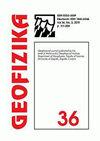Combined ERT and borehole logs for mapping the soil-rock interface in a granitic environment
IF 1.1
4区 地球科学
Q4 GEOCHEMISTRY & GEOPHYSICS
引用次数: 1
Abstract
This study used the efficiency of electrical resistivity tomography (ERT) and borehole logs to map the soil-rock interface beneath four traverses (RS1, RS2, RS3, and RS4) in the granitic terrain of Perak, Peninsular Malaysia. The study aimed to evaluate the impacts of the soil-rock characteristic features and interfaces on groundwater and infrastructure development to meet the needs of the increasing inhabitants yearly. The borehole- and ERT-derived lithologic units are strongly correlated. The delineated lithologic units include the topsoil, weathered granitic units (medium stiff to hard silty clay or clayey silt with <800 Ωm), thin to wide-sized weathered/fractured units, and fresh granitic bedrock. These soil-rock profiles and weathered/fractured apertures support sustainable groundwater developments with drill depths above 45 m. In contrast, the delineated clay/silt alternating with stiffer soils, low load-bearing deep-weathered/fractured zones, and bedrock boulders in most places, except beneath traverse RS3, have high affinities for water retention and differential stresses. These features can adversely impact poorly reinforced foundations. Hence, structural elements of the foundations, such as footings or piles, should be placed on stable bedrock, particularly in the central to western parts of the study area. This study has reduced the paucity of information on using ERT and borehole logs for soil-rock interface studies in the study area.用于绘制花岗岩环境中土壤-岩石界面的ERT和钻孔日志
本研究利用电阻率层析成像(ERT)和钻孔测井的效率绘制了马来西亚半岛霹雳花岗岩地形中四条导线(RS1、RS2、RS3和RS4)下方的土壤-岩石界面图。该研究旨在评估土壤-岩石特征和界面对地下水和基础设施发展的影响,以满足每年增加的居民的需求。钻孔和ERT衍生的岩性单元具有很强的相关性。划定的岩性单元包括表层土、风化花岗岩单元(中等硬度至坚硬的粉质粘土或粘质粉土,<800Ωm)、薄至宽尺寸的风化/断裂单元和新鲜花岗岩基岩。这些土壤-岩石剖面和风化/断裂孔隙支持钻孔深度超过45m的可持续地下水开发。相反,除导线RS3下方外,大多数地方的划定粘土/粉土与较硬的土壤、低承载力深度风化/断裂带和基岩巨砾交替,对保水性和差应力具有很高的亲和力。这些特征可能会对加固不良的基础产生不利影响。因此,基础的结构元件,如基脚或桩,应放置在稳定的基岩上,特别是在研究区域的中部至西部。本研究减少了在研究区域内使用ERT和钻孔日志进行土壤-岩石界面研究的信息匮乏。
本文章由计算机程序翻译,如有差异,请以英文原文为准。
求助全文
约1分钟内获得全文
求助全文
来源期刊

Geofizika
地学-地球化学与地球物理
CiteScore
1.60
自引率
0.00%
发文量
17
审稿时长
>12 weeks
期刊介绍:
The Geofizika journal succeeds the Papers series (Radovi), which has been published since 1923 at the Geophysical Institute in Zagreb (current the Department of Geophysics, Faculty of Science, University of Zagreb).
Geofizika publishes contributions dealing with physics of the atmosphere, the sea and the Earth''s interior.
 求助内容:
求助内容: 应助结果提醒方式:
应助结果提醒方式:


